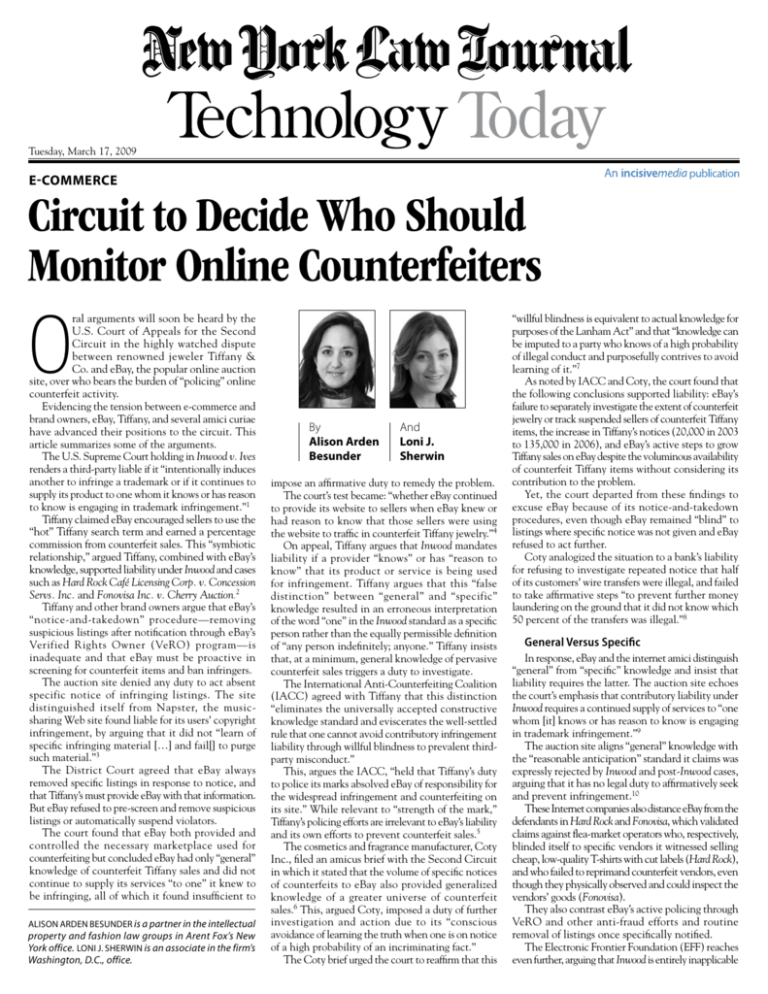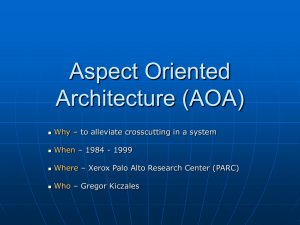
Tuesday, March 17, 2009
E-Commerce
Circuit to Decide Who Should
Monitor Online Counterfeiters
O
ral arguments will soon be heard by the
U.S. Court of Appeals for the Second
Circuit in the highly watched dispute
between renowned jeweler Tiffany &
Co. and eBay, the popular online auction
site, over who bears the burden of “policing” online
counterfeit activity.
Evidencing the tension between e-commerce and
brand owners, eBay, Tiffany, and several amici curiae
have advanced their positions to the circuit. This
article summarizes some of the arguments.
The U.S. Supreme Court holding in Inwood v. Ives
renders a third-party liable if it “intentionally induces
another to infringe a trademark or if it continues to
supply its product to one whom it knows or has reason
to know is engaging in trademark infringement.”1
Tiffany claimed eBay encouraged sellers to use the
“hot” Tiffany search term and earned a percentage
commission from counterfeit sales. This “symbiotic
relationship,” argued Tiffany, combined with eBay’s
knowledge, supported liability under Inwood and cases
such as Hard Rock Café Licensing Corp. v. Concession
Servs. Inc. and Fonovisa Inc. v. Cherry Auction.2
Tiffany and other brand owners argue that eBay’s
“notice-and-takedown” procedure—removing
suspicious listings after notification through eBay’s
Verified Rights Owner (VeRO) program—is
inadequate and that eBay must be proactive in
screening for counterfeit items and ban infringers.
The auction site denied any duty to act absent
specific notice of infringing listings. The site
distinguished itself from Napster, the musicsharing Web site found liable for its users’ copyright
infringement, by arguing that it did not “learn of
specific infringing material […] and fail[] to purge
such material.”3
The District Court agreed that eBay always
removed specific listings in response to notice, and
that Tiffany’s must provide eBay with that information.
But eBay refused to pre-screen and remove suspicious
listings or automatically suspend violators.
The court found that eBay both provided and
controlled the necessary marketplace used for
counterfeiting but concluded eBay had only “general”
knowledge of counterfeit Tiffany sales and did not
continue to supply its services “to one” it knew to
be infringing, all of which it found insufficient to
Alison Arden Besunder is a partner in the intellectual
property and fashion law groups in Arent Fox’s New
York office. Loni J. Sherwin is an associate in the firm’s
Washington, D.C., office.
By
Alison Arden
Besunder
And
Loni J.
Sherwin
impose an affirmative duty to remedy the problem.
The court’s test became: “whether eBay continued
to provide its website to sellers when eBay knew or
had reason to know that those sellers were using
the website to traffic in counterfeit Tiffany jewelry.”4
On appeal, Tiffany argues that Inwood mandates
liability if a provider “knows” or has “reason to
know” that its product or service is being used
for infringement. Tiffany argues that this “false
distinction” between “general” and “specific”
knowledge resulted in an erroneous interpretation
of the word “one” in the Inwood standard as a specific
person rather than the equally permissible definition
of “any person indefinitely; anyone.” Tiffany insists
that, at a minimum, general knowledge of pervasive
counterfeit sales triggers a duty to investigate.
The International Anti-Counterfeiting Coalition
(IACC) agreed with Tiffany that this distinction
“eliminates the universally accepted constructive
knowledge standard and eviscerates the well-settled
rule that one cannot avoid contributory infringement
liability through willful blindness to prevalent thirdparty misconduct.”
This, argues the IACC, “held that Tiffany’s duty
to police its marks absolved eBay of responsibility for
the widespread infringement and counterfeiting on
its site.” While relevant to “strength of the mark,”
Tiffany’s policing efforts are irrelevant to eBay’s liability
and its own efforts to prevent counterfeit sales.5
The cosmetics and fragrance manufacturer, Coty
Inc., filed an amicus brief with the Second Circuit
in which it stated that the volume of specific notices
of counterfeits to eBay also provided generalized
knowledge of a greater universe of counterfeit
sales.6 This, argued Coty, imposed a duty of further
investigation and action due to its “conscious
avoidance of learning the truth when one is on notice
of a high probability of an incriminating fact.”
The Coty brief urged the court to reaffirm that this
“willful blindness is equivalent to actual knowledge for
purposes of the Lanham Act” and that “knowledge can
be imputed to a party who knows of a high probability
of illegal conduct and purposefully contrives to avoid
learning of it.”7
As noted by IACC and Coty, the court found that
the following conclusions supported liability: eBay’s
failure to separately investigate the extent of counterfeit
jewelry or track suspended sellers of counterfeit Tiffany
items, the increase in Tiffany’s notices (20,000 in 2003
to 135,000 in 2006), and eBay’s active steps to grow
Tiffany sales on eBay despite the voluminous availability
of counterfeit Tiffany items without considering its
contribution to the problem.
Yet, the court departed from these findings to
excuse eBay because of its notice-and-takedown
procedures, even though eBay remained “blind” to
listings where specific notice was not given and eBay
refused to act further.
Coty analogized the situation to a bank’s liability
for refusing to investigate repeated notice that half
of its customers’ wire transfers were illegal, and failed
to take affirmative steps “to prevent further money
laundering on the ground that it did not know which
50 percent of the transfers was illegal.”8
General Versus Specific
In response, eBay and the internet amici distinguish
“general” from “specific” knowledge and insist that
liability requires the latter. The auction site echoes
the court’s emphasis that contributory liability under
Inwood requires a continued supply of services to “one
whom [it] knows or has reason to know is engaging
in trademark infringement.”9
The auction site aligns “general” knowledge with
the “reasonable anticipation” standard it claims was
expressly rejected by Inwood and post-Inwood cases,
arguing that it has no legal duty to affirmatively seek
and prevent infringement.10
These Internet companies also distance eBay from the
defendants in Hard Rock and Fonovisa, which validated
claims against flea-market operators who, respectively,
blinded itself to specific vendors it witnessed selling
cheap, low-quality T-shirts with cut labels (Hard Rock),
and who failed to reprimand counterfeit vendors, even
though they physically observed and could inspect the
vendors’ goods (Fonovisa).
They also contrast eBay’s active policing through
VeRO and other anti-fraud efforts and routine
removal of listings once specifically notified.
The Electronic Frontier Foundation (EFF) reaches
even further, arguing that Inwood is entirely inapplicable
tuesday, march 17, 2009
because eBay does not possess or access the goods and
lacks the ability to discern infringements.
The dispute regarding “knowledge” appears
semantical. Both sides agree that Inwood’s “know
or has reason to know” standard applies; the extant
question is its interpretation. In addition to arguing
that the law requires specific knowledge, eBay
casts Tiffany’s position as urging the restatement’s
“reasonable anticipation” standard. (Restatement
[Third] Unfair Competition section 27, 1995).
The auction site argued that the U.S. Supreme
Court rejected this type of “constructive knowledge”
in Inwood , but IACC counter-argued that the
Second Circuit previously considered, as probative of
liability, that “awareness of widespread infringement
was a form of evidence that satisfied the ‘reason to
know’ standard.”11
Moreover, the law requires knowledge, not notice.
The auction site’s insistence on “specific knowledge”—
i.e., notice—could be viewed as an attempt to distract
from the true knowledge issue. Arguably, the record
facts support a finding that eBay both fulfilled and
violated its duty under either standard: despite eBay’s
notice-and-takedown procedure, it shielded itself
from further investigating the scope of counterfeiting
beyond what Tiffany alerted it to.
The court will have to determine whether eBay’s
affirmative steps on one side of the equation absolves
its simultaneously accruing liability on the other.
Burden Shifting
Although it claimed to “leave open” the question
of who can better monitor counterfeiting online, the
district court answered that very question by imposing
the burden on Tiffany.
Tiffany argues on appeal that this “erroneously
balanced what eBay did and did not do against
what Tiffany did and did not do to protect its
marks,” and that the proper focus is the defendant’s
knowledge, not plaintiff’s action or inaction. Coty
(supported by Tiffany and the Council of Fashion
Designers of America) argued that this erroneously
“subtracted the effects of Tiffany’s policing effort
from the high level of counterfeiting on eBay,”
creating an inappropriate defense to illegal behavior
by “canceling out” eBay’s legal duty to prevent
recurrences of widespread counterfeiting.12
Tiffany argues that eBay is best equipped to
use technology to pre-screen, delay and remove
potentially infringing listings, but that eBay relies
primarily on VeRO despite brand owners’ complaints
of its ineffectiveness.
According to Tiffany, eBay regularly allowed its
sellers to offer thousands of counterfeit Tiffany items
at any time, despite knowledge of the growing problem
since at least 2003. Tiffany argues that the ruling thus
“favors the party that has profited from facilitating
the fraud and disfavors the two groups of victims that
the trademark law is designed to protect,” specifically,
consumers and trademark owners.
This, the Council of Fashion Designers of America
says, is daunting for all brands but particularly
devastating to smaller companies, who cannot
afford the staff or monetary resources necessary to
satisfy the court’s burden and would be forced out
of business while counterfeiters continue to reap
financial windfalls.
The council urges the circuit court to place
the policing burden not on the victims but on the
company creating, maintaining, and profiting from
the problem.
Other interested Internet businesses in turn argue
that a burden on them would cripple e-commerce and
create “impracticable burdens” and “uncertainty” as
to how much “generalized knowledge” would trigger
a duty to act.13
They ask how much notice—5 percent of
items identified?—would be necessary to consider
“generalized knowledge” to have been acquired.
Some (eBay, EFF, and Yahoo!) argued that their
business models would collapse because they lack
access to inspect the physical goods, and brand owners
acknowledge specialized training is required to identify
counterfeit products.14
Absent the ability to physically inspect, the other
Internet businesses argued that any policing burden
on them would require using over-inclusive search
criteria that might curtail some counterfeit listings
while also excluding legitimate ones.15
Amazon.com added that Tiffany’s proposal to ban
listings containing “5 or more” items as per se counterfeit
would be inappropriate for less costly items of other
brand owners that are often sold in bulk.16 The ecommerce briefs argued that they would each need to
Tiffany claimed eBay encouraged
sellers to use the ‘hot’ Tiffany search term
and earned a percentage commission
from counterfeit sales. This ‘symbiotic
relationship,’ argued Tiffany, combined with
eBay’s knowledge, supported liability.
tailor search criteria to “red flag” counterfeits of countless
trademark owners with a counterfeit problem.17
This, they argue, would limit consumer choice
and destroy the legitimate secondary goods market,
rewarding Tiffany by eliminating competition from
the secondary market and suppressing legitimate sales
in order to defeat some illegal ones.
Burden Sharing
The appeal will undoubtedly impact the future
of e-commerce with respect to trademark law. The
court cannot avoid considering the practicalities
of the situation in trying to resolve the legal
issue of not only who should bear the burden of
monitoring for illegal counterfeits but how it can
be accomplished.
Since neither Tiffany nor eBay can singlehandedly solve the problem, the practical solution
is burden sharing, not shifting. Leaving aside eBay’s
ultimate liability for its prior actions, a burdensharing scenario requires eBay to monitor—with
the brand owners’ assistance.
Prior attempts were both unsatisfactory and
insufficient in this regard. eBay’s primary access to
listings enables it to pull listings bearing certain
indicia of counterfeit (i.e., keywords, number of items,
low-starting prices, high-selling completion rates,
negative feedback, identical text), all of which can
be narrowly tailored to particular brands, and place
them in a temporary “hold” pending investigation
by both eBay and Tiffany.
Tiffany would then be required to review the
listings and notify eBay as to whether the goods are
counterfeit or whether further investigation is needed.
Any listings on which Tiffany takes no action could
then be posted, without waiving further rights to
later notify eBay.18
In addition, eBay should be required to accompany
all “Tiffany”-related postings or advertising with a
prominent disclaimer clarifying its inability to
guarantee the authenticity of trademarked goods
sold on eBay addresses this issue.
Despite other measures, there is no indication that
eBay has implemented prominent disclaimers attached
to specific Tiffany-related listings or advertising. This
would help to abate counterfeiting and balance the
competing concerns raised by alerting consumers at
the immediate “point of sale” of the possibility that
the goods are not genuine, to conduct their own
investigation, and to proceed at their own risk given the
high incidence of counterfeit Tiffany sold on eBay.
These types of practical and reasonable steps that
eBay did not implement should be considered in any
determination of how to truly distribute the burden
and address the heart of the problem.
••••••••••••••••
•••••••••••••
1. 456 U.S. 844, 853-854 (1982).
2. Hard Rock Cafe Licensing Corp. v. Concession Servs. Inc., 955
F.2d 1143 (7th Cir. 1992); Fonovisa Inc. v. Cherry Auction, 76 F.3d
259 (9th Cir. 1996).
3. A&M Records Inc. v. Napster Inc., 239 F.3d 1004, 1021 (9th
Cir. 2001).
4. Tiffany, 576 F. Supp 2d at 506-508, citing Inwood, 46 U.S.
at 854.
5. Id. at 22. The blogosphere reacted strongly to the district
court’s interpretation of Inwood’s knowledge standard. One
commentator opined, “The Second Circuit should remand for
proof on this point: what has eBay done to satisfy the burden
on it to avoid ‘willful blindness’ of the illegal activity from
which it is profiting so magnificently? And in doing so, the
Circuit should enunciate how that level of prevention is to
be weighed when compared to eBay’s overall profitability….”
www.likelihoodofconfusion.com/?=1728. One post asked,
“What, exactly, are you expecting eBay to do?”; another replied,
“Any time (sic) you do something that makes you liable for
infringement, you have a legal obligation to stop doing it, not to
say ‘what am I supposed to do?’ You’re supposed to not break the
law or provide resources for others to break the law, especially
when in the latter case you’re profiting from that activity.”
6. To illustrate the volume, eBay’s 2007 net revenues totaled
$7.6 billion from 84 million worldwide users and 6 million new
listings daily (100 million at any given time). The District Court
calculated nearly 500,000 sales of all Tiffany jewelry in five years,
earning eBay over $4.1 million. Tiffany (NJ) Inc. v. Ebay Inc., 576
F. Supp. 2d 463, 581 (S.D.N.Y. 2008). Amicus Coty alleges that
eBay hosts 750 new offers of Coty brands daily, resulting in nearly
15,000 complaints and warning letters over five years, including
160 letters requesting the suspension of repeat offenders. Coty
brief at 5.
7 . Coty brief at 13, citing, inter alia, Hard Rock Cafe, 955
F.2d at 1149.
8. Coty brief at 20 citing Financial Crimes Examination
Network, In re American Express International Bank, No. 2007-1.
9. Brief of Defendant-Appellee eBay (eBay) at 34, citing
Inwood Labs. Inc. v. Ives Labs. Inc., 456 U.S. 844, 854 (1982).
10. eBay at 37, 41.
11. IACC at 16 citing Ives, 601 F.2d at 644 and Ives, 638 F.2d
at 543.
12. Tiffany at 38; CFDA at 8-9; see also Coty brief at 21-22,
citing Tiffany, 576 F. Supp. 2d at 512-513. Coty points out that
the mark owner’s duty to police its mark exists independent of the
provider’s duty to prevent the recurrence of counterfeiting after
acquiring knowledge of a “high probability of illegal conduct,” and
“[t]he two duties do not offset each other.” Coty brief at 22.
13. Brief of Amici Curiae of Amazon.com Inc.; Google Inc.;
Information Technology Association of America; Internet
Commerce Coalition; Netcoalition; United States Internet
Service Provider Association; and United States Telecom
Association ( Amazon Brief) at 10, 15.
14. eBay at 44; Yahoo! at 16; EFF at 9.
15. EFF at 4 (internal citation omitted). The district court
found that “a substantial number of authentic Tiffany goods are
sold on eBay, including both new and vintage silver jewelry,
sometimes in lots of five or more.”
16. Amazon at 13.
17. Id. at 13-14.
18. Coty claims eBay rejected its proposal to take steps similar
to these concepts. Coty brief at 6.
Reprinted with permission from the March 17, 2009 edition
of the NEW YORK LAW JOURNAL© 2009 Incisive US
Properties, LLC. All rights reserved. Further duplication without
permission is prohibited. For information, contact 877-257-3382
or reprintscustomerservice@incisivemedia.com. # 070-03-09-29







